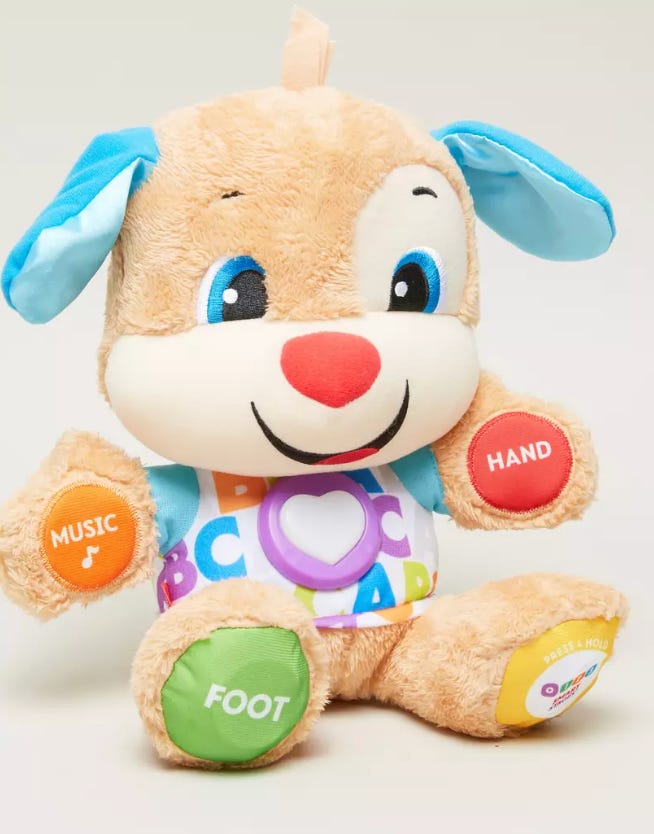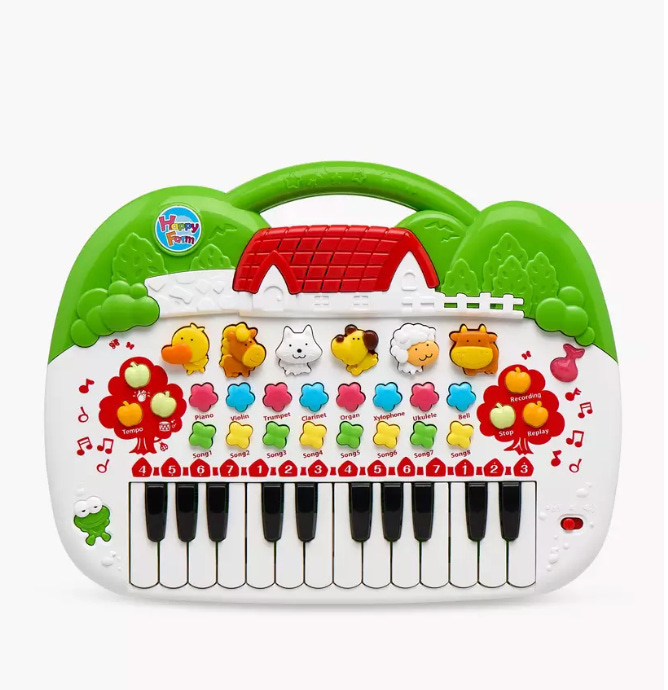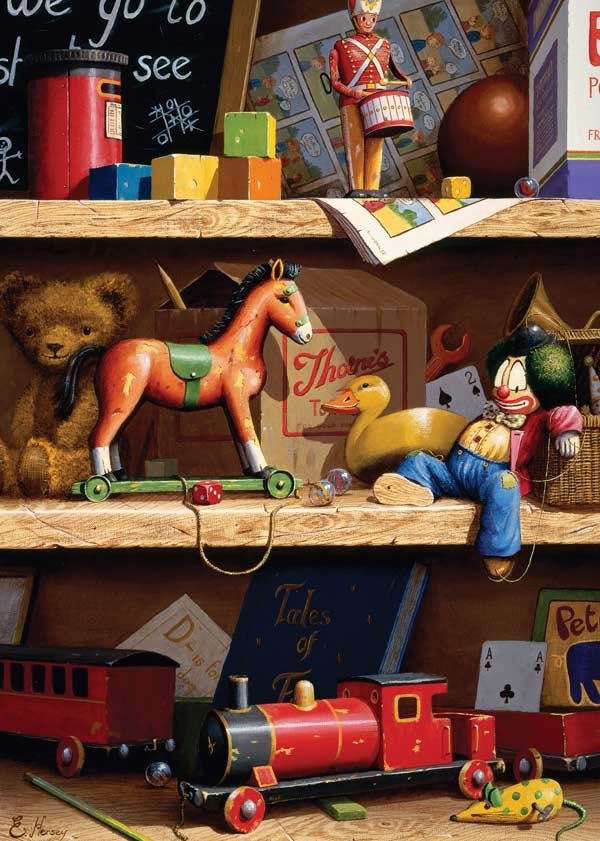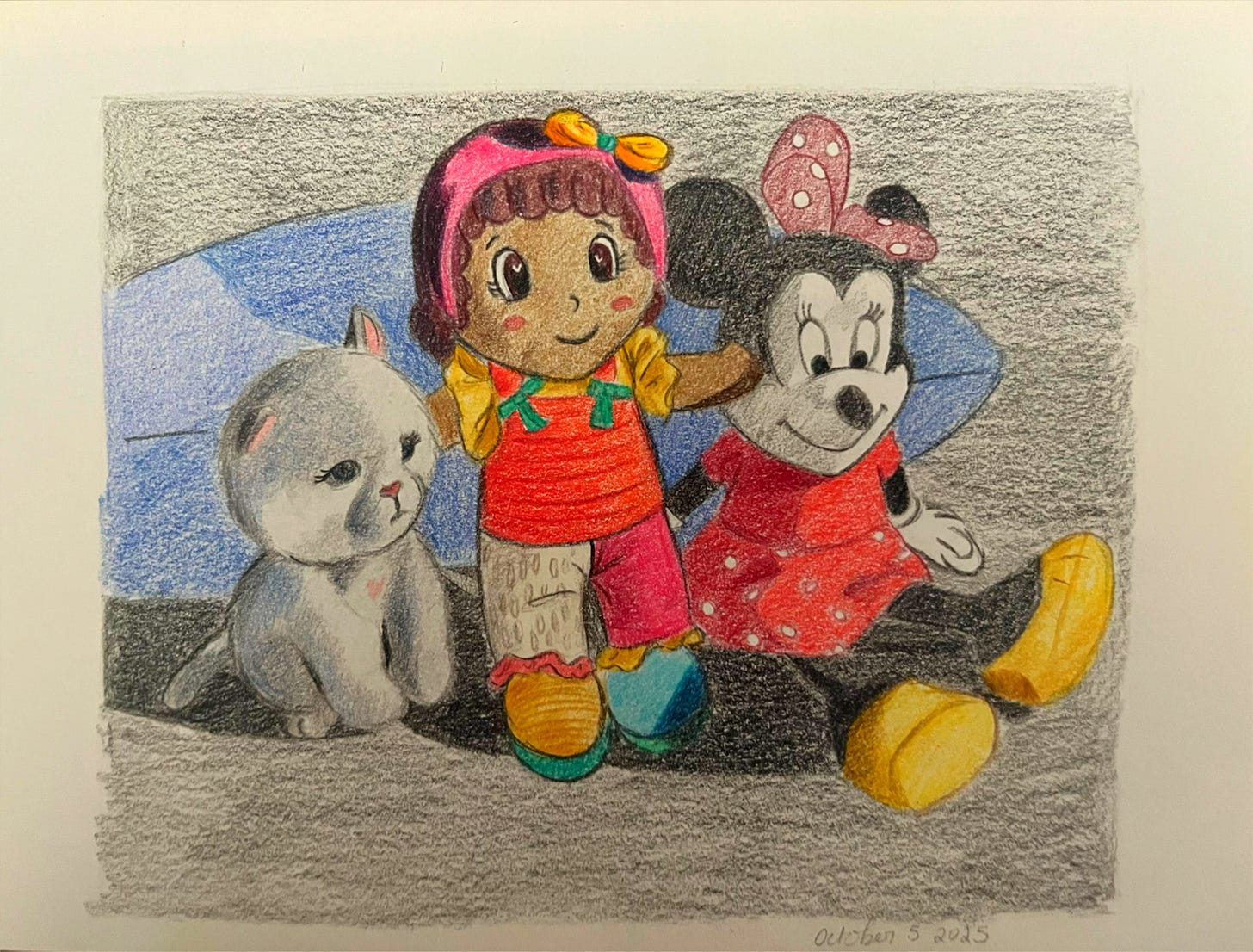The Philosophy of Toys
How to Play with your Children so they don’t become AI Labubus with ADHD
The elves are very busy right now at the North Pole, working away to make beautiful things for Santa Claus to deliver to the children at Christmas. Do you imagine they’re making AI labubus that will speak chthonic secrets to their tender ears? Do you imagine they’re hard at work assembling disabled fat black barbie who is an astronaut? Do you imagine the elves, with little hammers in their hands, are making yet another hot pink, neon blue plastic box with lots of buttons that play sounds and pretend to be “educational”. From the look of toy-stores today, it seems that they are, and all the elves need to be fired, or at the very least re-trained. There are good toys and there are bad toys and there is very good reasoning behind this philosophy of toys that goes beyond mere aesthetics...and it begins by realising that aesthetics are not “merely” frivolous.
I live in Dubai, which is child central for the whole world it seems. Toddlers outnumber adults here in most public places. Restaurants are overrun with strollers, there is a large baby change and nursing area in almost every public place we go, and stroller ramps are not difficult to find. The entire second floor of Dubai Mall is dedicate to babies…although I wonder who is really shopping at Baby Dior and buying Burberry Strollers, but that’s Dubai for you. So it is here that I notice most strongly the worldwide trend in the denigration of toys.
Toys simply do not look like toys anymore. Modern toys are to real toys what corn syrup is to sugar. It may appeal to children as well as sugar does, but it is slowly poisoning them, all so someone with lots of money and self-righteousness can make a bit of money. And like with nutrition and health, understanding the philosophy of the real toy is crucial for parents to help protect their children’s minds and imaginations against the depredations of modernity.
Here are some examples of modern toys that fill “toy sections”:
All of these toys claim to teach something, but this is a lie. All they really do is distract the child so that the parent can get on with doing whatever else is more important for them to do than to play with their child.
One serious culprit is Leapfrog books. I hate this toy! It is a sound book that claims to teach children vocabulary because every page is touch sensitive and when the child’s little finger touches the image, the book tells them what it is. But in my experience, all this does is create a lot of commotion. The child doesn’t listen to the word and then repeat it, or practice it, they just press as many pictures as they can to hear all the new sounds. Their already short attention span is actively reduced by this toy and others like it as they search for more and more novelty within the toy at greater and greater speeds. Paired with vomitrociously ugly artwork that doesn’t ressemble the object they claim to teach the child about, there is no learning going on at all, only distraction. Instead of Leapfrog books for vocabulary, it is better for the parent to find a real, paper book, with beautiful and realistic illustrations and spend some time reading with the child. I’ve done this and found that with these other kinds of books, the real books, with real pictures, the child ends up poring over them on their own time as well, just looking at the pictures, taking in far more and with greater attention than if that picture somehow sang and danced for them.
All toys are educational to a child because a child is a sponge that learns from everything he can get his hands on. However, “educational toys” such as the ones that fill toy stores and early learning centres today, are often the only type of toy that is not serving the child’s true education. This is because educational toys attempt to teach children about abstract concepts at a stage when they are primarily concerned with and need to learn the concrete. An example of this is a sound playing toy that “teaches” a child the ABCs or counting or the names of animals. This is not merely useless, it is anti-educational. A child learns the names of things when he sees something, and wishes to call it by something. He learns what a dog is when he sees a dog. He learned to count when he has things he needs to keep track of like beads or blocks. He may learn the ABCs through a song but won’t really understand what it’s for until he has acquired some vocabulary through conversation with people and pointing to things in his life and naming them. When an educational toy, a brightly coloured plastic sound machine, delights a child, it appeals to the child’s sense of novelty and hyper-sensory attraction. In doing so, the child is attracted to the toy, but then is distracted from real toys.
Toys like dolls, toy cars, blocks, boxes, balls or even things that exist in his ordinary life and he may interact with and explore. In fact, many a parent may have noticed that these shiny bright sound machine toys are quickly expended with and thrown to the side the moment they are no longer “new”. It’s just a way for these companies to make money while appealing to parents’ sense of “helping their child learn”.
“But my child doesn’t really play with the boring toys” say many parents. They might have been given a set of boring old blocks that don’t light up or talk to them and not have been interested. A simple rag doll might not hold a candle to a doll that sings the alphabet and has lots of little buttons and rattles attached. This is because the little child, especially one that is younger than 5, has a very short attention span naturally; his will is as unformed as his kneecaps. As their bones are surrounded by squishy flesh, so is their will and their character. They don’t have the ability, as we do, to persevere through a dull moment and rediscover deeper enchantment through patience. This is why God has given these children to us, as adults, to be their will and their character for them. We are the frame they must cling to, to grow.
When the child is playing with a toy, and you notice he beings to grow bored with it, bring their attention back to it, show him some new and wonderful way to look at or play with the toy. Even a daisy is interesting to a child at first, but then she will quickly become bored of it. It is then that the mother may point out that the daisy has a yellow eye and white eye lashes and spends its day looking up at the sun. It is the day’s eye, which is why it is called the “daisy”. (I got this example from Charlotte Mason’s writings) She might even hug the daisy and give it a little kiss. Children mainly want one thing, more than any toy in the world, and it is to spend time with us. It may be inconvenient to many people, but it is true that in the early stages of infancy, the first three years of a child’s life, you must play with them a lot more. Of course there is time to give them a set of keys and let them be distracted for 20 minutes while you prepare the dinner for the oven. But you must also make time to sit with them and play with their toys with them. The simpler toys actually allow for more playing because there is more room for imagination and more games that are possible.
We must bring back little toy trains and cars, little toy animals that don’t speak or sing, but are simply beautiful and accurate figurines. We must bring back pretty little dolls that have no political agenda behind them. Little baby dolls with baby bottles. Blocks the child can put together and take apart, stack and unstack, make a tower or a pyramid. Teddy bears that don’t say anything, just offer a soft hug. If a toy has a button on it of any kind, look at it with great suspicion as a thing that is just an assault on your child’s attention span and ability to truly play.
Moreover, these traditional, low-tech toys are also far more beautiful to look at. When you see these kind of toys scattered around a nursery or a living room, they are not so ugly to see. Modern toys, once the lustre of newness fades, just look like cheap landfill in your home. The gaudy unnatural colours and the irritating sounds are not just ugly and irritating to adults, but to babies as well. Toys and baby things made of natural materials, which are low-tech, are beautiful, and not only look aesthetically pleasing, but by surrounding your child with beauty, you regulate their nervous system to be calmer, and you help to cultivate in them a sense of beauty as well. This sense of beauty is like all good things: once it is cultivated and finds root in a personality, it grows and gathers like good things to itself. One good thing attracts other good things. One bad things attracts other bad things.
Furthermore, low tech toys can be mended, fixed and maintained for years and generations to come. Whereas the high tech, button filled, digital toys tend to break down in just a few years and cannot even be fixed. When the child sees toys being bought and thrown away frequently enough, they begin to grow accustomed to a poisonous consumerist idea of the world, in which they believe that everything can be discarded. All their belongings are just future garbage. How much more beautiful a character may we cultivate in our children and in ourselves if we buy things with the intention to keep them forever or at least to pass them down? There is a big problem of litter in the world today, and I think it partly comes from the mass amounts of garbage manufactured today.
Living in Dubai, I don’t have as ready access to greenery as I do in England or Canada. However, when I recently spent a summer in England, I noticed another big thing about toys: when children are outside in nature, they don’t care about them. There is a local park I go to in Dubai which is very crowded and because it is crowded and small, all the children bring their toys. The whole place is littered with toddler bikes and toddler cars and scooters. The children spend all their time comparing toys and coveting each others’ things. They are not playing with each other. On the weekends, I take my children to a much bigger park, with great big green meadows to frolick in. In these spaces, my children, and everyone else’s, leaves any toys they bring with the stroller and they are all busy running, crawling, jumping, skipping and playing!
The best educational toy for children, is not any toy at all, but just nature and sunshine!
I will summarize the key points for you here.
Children are not cognitively prepared to learn abstract concepts before the age of three; rather, they must begin by learning concrete concepts by experiencing the world and looking at beautiful pictures in context. Therefore most ‘educational toys’ targeted to children before the age of 5 are largely useless for educational purposes and moreover distract children from play and games that are far more beneficial to their development.
Children have a short attention span which must be nurtured by constantly bringing their attention back to the simple toy they are playing with. Even little infants can be taught to pay greater attention than they are naturally capable of on their own with the help with their parent helping them to attend. While this may take a lot of work in the beginning, it pays off long term by developing a child that has a greater ability to concentrate.
The best toys for your children coincidentally are also more beautiful and more long-lasting. They cultivate in your child not only a sense of beauty, but also a sense of respect for their belongings and that everything is not future garbage.
Children are far less concerned with material possessions than we believe. The best educational entertainment for your child is simply to be outdoors in nature, in the fresh air and sunshine. They care a lot less about toys when they have access to this.









